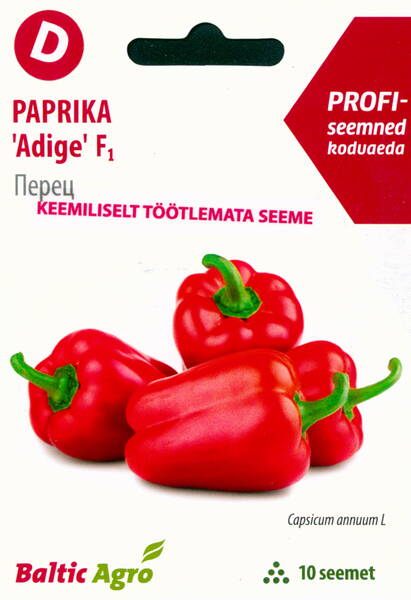Mid-early hybrid variety for open and protected ground.
The period from planting seedlings to fruiting is 80-90 days. The fruit is cuboid, 10-12 cm long, 9-11 cm wide, wall thickness 6-8 mm.
Fruit weight up to 400 g. Colouring in biological ripeness is red. The variety is resistant to tobacco mosaic virus. Universal use.
Agricultural technology.
Loamy, breathable soils are suitable for pepper. Good predecessors are cucumber, cabbage, legumes.
Before sowing, the seeds are treated in a solution of potassium permanganate, then washed with clean water. Picking in the phase of 1-2 true leaves.
Seedlings are planted at the age of 70-80 days (when the threat of frost has passed). Landing pattern - 70x40 cm.
Watering should be done after sunset, with warm water. Top dressing should be carried out during the entire growing season.
* Growing peppers in open ground.
Good predecessors for peppers are cabbage, root vegetables, pumpkin crops, and legumes.
Pepper plants are planted in open ground when the average daily air temperature remains stable at +13+15 °C, and there is no danger of frost returning. Planting seedlings prematurely is risky, because in cold soil the plants weaken, develop poorly, and are easily exposed to pathogens.
The planting pattern depends on the variety. Seedlings of medium-growing varieties are planted at a distance of 70 x 30-35 cm (6 plants per m2), tall and densely leafed varieties - 70 x 40-45 cm (4-5 plants per m2).
Plant seedlings in well-watered holes. The plant is placed in the hole at the same depth at which it grew in the pot; the depth is allowed no more than 1-2 cm. The roots are pressed tightly with soil. From above, around the planted seedlings, the soil must be mulched with peat to prevent the evaporation of moisture from the soil.
Plants are best planted on cloudy days or in the evening. At the same time, the plants get sick less, take root well and quickly begin to grow.
To ensure better water-air and temperature conditions on pepper plantings, soil mulching is used. Black or white polyethylene film or non-woven agrofibre is used as mulch. To do this, the bed is covered with the selected material, round holes are made through which the seedlings are planted. Pepper plants planted under mulch are faster in growth and development than plants placed on beds without mulch. In addition, when mulching there is no need to destroy weeds and loosen the soil.
Caring for plantings includes frost protection, loosening row spacing, fertilizing, watering, weed control and protection from diseases and pests. Water pepper plants at the root to avoid water getting on the leaves and flowers. After watering, the soil must be loosened, but carefully, since the root system is shallow. It is better to water with warm water. It is not recommended to water during the hottest part of the day.
For feeding, complex mineral fertilizer NPK is used, enriched with a wide range of microelements. During the growing season, fertilize the plants 2-3 times. The time for the first feeding is 10-15 days after planting in the ground. After 10-15 days, when the ovary forms on the plants, a second feeding is given. The third and, if necessary, the fourth time, the peppers are fed at the moment of mass formation and filling of fruits.















